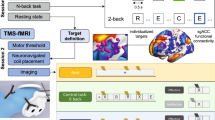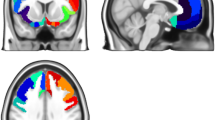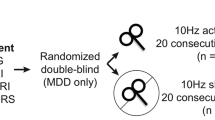Abstract
Resting-state magnetic resonance imaging (RS-fMRI) studies indicated that the repetitive transcranial magnetic stimulation (rTMS) exerts antidepression effect through the functional connectivity (FC) of the DLPFC with the subgenual anterior cingulate cortex (sgACC), pregneual ACC (pgACC), or nucleus accumbens (NAc). It is proposed that the FC-guided individualized precise stimulation on the DLPFC would be more effective. The current study systematically investigated the reliability of the RS-fMRI FC location as well as the FC strength with multiple potential factors. We aimed to provide a stable stimulation target for future FC-guided TMS therapy for affective related disorders. Twenty-one subjects under RS-fMRI conditions with the first two times (V1, V2) scanned on a GE 3 T scanner and the third visit (V3) on a Siemens 3 T scanner. Then the FC strength and location reliability were assessed by using intra-class correlation (ICC) and intra-individual distance, respectively. The factors included deep seed ROIs (midline (mid-) sgACC, left pgACC, mid-pgACC, and left NAc), eyes closed (EC) vs eyes open (EO), frequency bands, FC algorithm (Pearson vs Spearman), scanning length (half a session vs whole session), and location method (FC peak vs center of gravity (COG)). The reliability of the voxel-wise FC strength was low to moderate. The intra-individual distances of the COG were 3.8–7.3 mm across all factors, much smaller than that of FC peak (approximately 30 mm). The COG of seed-based FC might be a potential rTMS stimulation target. Anyway, all potential stimulation targets should be tested in future rTMS treatment studies.





Similar content being viewed by others
References
Admon, R., Kaiser, R. H., Dillon, D. G., Beltzer, M., Goer, F., Olson, D. P., Vitaliano, G., & Pizzagalli, D. A. (2017, Apr 1). Dopaminergic Enhancement of Striatal Response to Reward in Major Depression. American Journal of Psychiatry, 174(4), 378–386. https://doi.org/10.1176/appi.ajp.2016.16010111
Baldessarini, R. J., Lau, W. K., Sim, J., Sum, M. Y., & Sim, K. (2015, Feb). Duration of initial antidepressant treatment and subsequent relapse of major depression. Journal Clinical Psychopharmacology, 35(1), 75–76. https://doi.org/10.1097/jcp.0000000000000263
Berlim, M. T., van den Eynde, F., Tovar-Perdomo, S., & Daskalakis, Z. J. (2014, Jan). Response, remission and drop-out rates following high-frequency repetitive transcranial magnetic stimulation (rTMS) for treating major depression: a systematic review and meta-analysis of randomized, double-blind and sham-controlled trials. Psychological Medicine, 44(2), 225–239. https://doi.org/10.1017/s0033291713000512
Cao, X., Deng, C., Su, X., & Guo, Y. (2018). Response and Remission Rates Following High-Frequency vs. Low-Frequency Repetitive Transcranial Magnetic Stimulation (rTMS) Over Right DLPFC for Treating Major Depressive Disorder (MDD): A Meta-Analysis of Randomized, Double-Blind Trials. Frontiers in Psychiatry, 9, 413. https://doi.org/10.3389/fpsyt.2018.00413
Cash, R. F. H., Cocchi, L., Lv, J., Fitzgerald, P. B., & Zalesky, A. (2021a, Mar 1). Functional magnetic resonance imaging-guided personalization of transcranial magnetic stimulation treatment for depression. JAMA Psychiatry, 78(3), 337–339. https://doi.org/10.1001/jamapsychiatry.2020.3794
Cash, R. F. H., Cocchi, L., Lv, J., Wu, Y., Fitzgerald, P. B., & Zalesky, A. (2021b, Feb 5). Personalized connectivity-guided DLPFC-TMS for depression: Advancing computational feasibility, precision and reproducibility. Human Brain Mapping. https://doi.org/10.1002/hbm.25330
Cash, R. F. H., Zalesky, A., Thomson, R. H., Tian, Y., Cocchi, L., & Fitzgerald, P. B. (2019, Jul 15). Subgenual functional connectivity predicts antidepressant treatment response to transcranial magnetic stimulation: Independent validation and evaluation of personalization. Biological Psychiatry, 86(2), e5-e7. https://doi.org/10.1016/j.biopsych.2018.12.002
Chen, J., Zhou, C., Wu, B., Wang, Y., Li, Q., Wei, Y., Yang, D., Mu, J., Zhu, D., Zou, D., & Xie, P. (2013, Dec 30). Left versus right repetitive transcranial magnetic stimulation in treating major depression: a meta-analysis of randomised controlled trials. Psychiatry Research, 210(3), 1260–1264. https://doi.org/10.1016/j.psychres.2013.09.007
Ciric, R., Wolf, D. H., Power, J. D., Roalf, D. R., Baum, G. L., Ruparel, K., Shinohara, R. T., Elliott, M. A., Eickhoff, S. B., Davatzikos, C., Gur, R. C., Gur, R. E., Bassett, D. S., & Satterthwaite, T. D. (2017, Jul 1). Benchmarking of participant-level confound regression strategies for the control of motion artifact in studies of functional connectivity. Neuroimage, 154, 174–187. https://doi.org/10.1016/j.neuroimage.2017.03.020
Deng, Z. D., Lisanby, S. H., & Peterchev, A. V. (2014, Jun). Coil design considerations for deep transcranial magnetic stimulation. Clinical Neurophysiology, 125(6), 1202–1212. https://doi.org/10.1016/j.clinph.2013.11.038
Du, L., Liu, H., Du, W., Chao, F., Zhang, L., Wang, K., Huang, C., Gao, Y., & Tang, Y. (2018, Mar 9). Stimulated left DLPFC-nucleus accumbens functional connectivity predicts the anti-depression and anti-anxiety effects of rTMS for depression. Translational Psychiatry, 7(11), 3. https://doi.org/10.1038/s41398-017-0005-6
Ernst, J., Hock, A., Henning, A., Seifritz, E., Boeker, H., & Grimm, S. (2017, Jan). Increased pregenual anterior cingulate glucose and lactate concentrations in major depressive disorder. Molecular Psychiatry, 22(1), 113–119. https://doi.org/10.1038/mp.2016.73
Fox, M. D., Buckner, R. L., White, M. P., Greicius, M. D., & Pascual-Leone, A. (2012, Oct 1). Efficacy of transcranial magnetic stimulation targets for depression is related to intrinsic functional connectivity with the subgenual cingulate. Biological Psychiatry, 72(7), 595–603. https://doi.org/10.1016/j.biopsych.2012.04.028
Jing, Y., Zhao, N., Deng, X. P., Feng, Z. J., Huang, G. F., Meng, M., Zang, Y. F., & Wang, J. (2020, Apr). Pregenual or subgenual anterior cingulate cortex as potential effective region for brain stimulation of depression. Brain and Behavior, 10(4), e01591. https://doi.org/10.1002/brb3.1591
Langenecker, S. A., Kennedy, S. E., Guidotti, L. M., Briceno, E. M., Own, L. S., Hooven, T., Young, E. A., Akil, H., Noll, D. C., & Zubieta, J. K. (2007, Dec 1). Frontal and limbic activation during inhibitory control predicts treatment response in major depressive disorder. Biological Psychiatry, 62(11), 1272–1280. https://doi.org/10.1016/j.biopsych.2007.02.019
Long, Z., Du, L., Zhao, J., Wu, S., Zheng, Q., & Lei, X. (2020). Nov 1). Prediction on treatment improvement in depression with resting state connectivity: A coordinate-based meta-analysis. Journal of Affective Disorders, 276, 62–68. https://doi.org/10.1016/j.jad.2020.06.072
Ma, Y. (2015, Mar). Neuropsychological mechanism underlying antidepressant effect: a systematic meta-analysis. Molecular Psychiatry, 20(3), 311–319. https://doi.org/10.1038/mp.2014.24
Malhi, G. S., & Mann, J. J. (2018, Nov 24). Depression. Lancet, 392(10161), 2299-2312. https://doi.org/10.1016/s0140-6736(18)31948-2
Ning, L., Makris, N., Camprodon, J. A., & Rathi, Y. (2019, Jan-Feb). Limits and reproducibility of resting-state functional MRI definition of DLPFC targets for neuromodulation. Brain Stimulation, 12(1), 129–138. https://doi.org/10.1016/j.brs.2018.10.004
Noble, S., Scheinost, D., & Constable, R. T. (2019, Dec). A decade of test-retest reliability of functional connectivity: A systematic review and meta-analysis. Neuroimage, 203, 116157. https://doi.org/10.1016/j.neuroimage.2019.116157
Noble, S., Scheinost, D., Finn, E. S., Shen, X., Papademetris, X., McEwen, S. C., Bearden, C. E., Addington, J., Goodyear, B., Cadenhead, K. S., Mirzakhanian, H., Cornblatt, B. A., Olvet, D. M., Mathalon, D. H., McGlashan, T. H., Perkins, D. O., Belger, A., Seidman, L. J., Thermenos, H., … & Constable, R. T. (2017, Feb 1). Multisite reliability of MR-based functional connectivity. NeuroImage, 146, 959–970. https://doi.org/10.1016/j.neuroimage.2016.10.020
Noble, S., Spann, M. N., Tokoglu, F., Shen, X., Constable, R. T., & Scheinost, D. (2017b, Nov 1). Influences on the Test-Retest Reliability of Functional Connectivity MRI and its Relationship with Behavioral Utility. Cereb Cortex, 27(11), 5415–5429. https://doi.org/10.1093/cercor/bhx230
Otte, C., Gold, S. M., Penninx, B. W., Pariante, C. M., Etkin, A., Fava, M., Mohr, D. C., & Schatzberg, A. F. (2016, Sep 15). Major depressive disorder. Nature Reviews Disease Primers , 2, 16065. https://doi.org/10.1038/nrdp.2016.65
Pizzagalli, D., Pascual-Marqui, R. D., Nitschke, J. B., Oakes, T. R., Larson, C. L., Abercrombie, H. C., Schaefer, S. M., Koger, J. V., Benca, R. M., & Davidson, R. J. (2001, Mar). Anterior cingulate activity as a predictor of degree of treatment response in major depression: evidence from brain electrical tomography analysis. American Journal of Psychiatry, 158(3), 405–415. https://doi.org/10.1176/appi.ajp.158.3.405
Pizzagalli, D. A. (2011, Jan). Frontocingulate dysfunction in depression: toward biomarkers of treatment response. Neuropsychopharmacology, 36(1), 183–206. https://doi.org/10.1038/npp.2010.166
Ren, X., Yu, S., Dong, W., Yin, P., Xu, X., & Zhou, M. (2020, May 1). Burden of depression in China, 1990–2017: Findings from the global burden of disease study 2017. Journal of Affective Disorders, 268, 95–101. https://doi.org/10.1016/j.jad.2020.03.011
Rossini, P. M., Burke, D., Chen, R., Cohen, L. G., Daskalakis, Z., Di Iorio, R., Di Lazzaro, V., Ferreri, F., Fitzgerald, P. B., George, M. S., Hallett, M., Lefaucheur, J. P., Langguth, B., Matsumoto, H., Miniussi, C., Nitsche, M. A., Pascual-Leone, A., Paulus, W., Rossi, S., Rothwell, J. C., Siebner, H. R., Ugawa, Y., Walsh, V., & Ziemann, U. (2015, Jun). Non-invasive electrical and magnetic stimulation of the brain, spinal cord, roots and peripheral nerves: Basic principles and procedures for routine clinical and research application. An updated report from an I.F.C.N. Committee. Clinical Neurophysiology, 126(6), 1071–1107. https://doi.org/10.1016/j.clinph.2015.02.001
Rush, A. J., Trivedi, M. H., Wisniewski, S. R., Nierenberg, A. A., Stewart, J. W., Warden, D., Niederehe, G., Thase, M. E., Lavori, P. W., Lebowitz, B. D., McGrath, P. J., Rosenbaum, J. F., Sackeim, H. A., Kupfer, D. J., Luther, J., & Fava, M. (2006, Nov). Acute and longer-term outcomes in depressed outpatients requiring one or several treatment steps: a STAR*D report. American Journal of Psychiatry, 163(11), 1905–1917. https://doi.org/10.1176/ajp.2006.163.11.1905
Shrout, P. E., & Fleiss, J. L. (1979, Mar). Intraclass correlations: uses in assessing rater reliability. Psychol Bull, 86(2), 420–428. https://doi.org/10.1037/00332909.86.2.420
Somandepalli, K., Kelly, C., Reiss, P. T., Zuo, X. N., Craddock, R. C., Yan, C. G., Petkova, E., Castellanos, F. X., Milham, M. P., & Di Martino, A. (2015, Oct). Short-term test-retest reliability of resting state fMRI metrics in children with and without attention-deficit/hyperactivity disorder. Developmental Cognitive Neuroscience, 15, 83–93. https://doi.org/10.1016/j.dcn.2015.08.003
Wassermann, E. M., & Zimmermann, T. (2012, Jan). Transcranial magnetic brain stimulation: therapeutic promises and scientific gaps. Pharmacology & Therapeutics, 133(1), 98–107. https://doi.org/10.1016/j.pharmthera.2011.09.003
Weigand, A., Horn, A., Caballero, R., Cooke, D., Stern, A. P., Taylor, S. F., Press, D., Pascual-Leone, A., & Fox, M. D. (2018, Jul 1). Prospective validation that subgenual connectivity predicts antidepressant efficacy of transcranial magnetic stimulation sites. Biological Psychiatry, 84(1), 28–37. https://doi.org/10.1016/j.biopsych.2017.10.028
Yan, C. G., Wang, X. D., Zuo, X. N., & Zang, Y. F. (2016, Jul). DPABI: Data Processing & Analysis for (Resting-State) Brain Imaging. Neuroinformatics, 14(3), 339–351. https://doi.org/10.1007/s12021-016-9299-4
Yuan, L. X., Wang, J. B., Zhao, N., Li, Y. Y., Ma, Y., Liu, D. Q., He, H. J., Zhong, J. H., & Zang, Y. F. (2018). Intra- and Inter-scanner Reliability of Scaled Subprofile Model of Principal Component Analysis on ALFF in Resting-State fMRI Under Eyes Open and Closed Conditions. Frontiers in Neuroscience, 12, 311. https://doi.org/10.3389/fnins.2018.00311
Zhao, N., Yuan, L. X., Jia, X. Z., Zhou, X. F., Deng, X. P., He, H. J., Zhong, J., Wang, J., & Zang, Y. F. (2018). Intra- and Inter-Scanner Reliability of Voxel-Wise Whole-Brain Analytic Metrics for Resting State fMRI. Frontiers in Neuroinformatics, 12, 54. https://doi.org/10.3389/fninf.2018.00054
Zhou, M., Hu, X., Lu, L., Zhang, L., Chen, L., Gong, Q., & Huang, X. (2017, Apr 3). Intrinsic cerebral activity at resting state in adults with major depressive disorder: A meta-analysis. Progress in Neuro-Psychopharmacology and Biological Psychiatry, 75, 157–164. https://doi.org/10.1016/j.pnpbp.2017.02.001
Zuo, X. N., & Xing, X. X. (2014, Sep). Test-retest reliabilities of resting-state FMRI measurements in human brain functional connectomics: A systems neuroscience perspective. Neuroscience and Biobehavioral Reviews, 45, 100–118. https://doi.org/10.1016/j.neubiorev.2014.05.009
Funding
This work was supported by the Key Realm R&D Program of Guangdong Province (2019B030335001), the National Natural Science Foundation of China (NSFC) (82071537, 81520108016), Key Medical Discipline of Hangzhou, and The Cultivation Project of the Province-leveled Preponderant Characteristic Discipline of Hangzhou Normal University (18JYXK046, 20JYXK004).
Author information
Authors and Affiliations
Corresponding authors
Additional information
Publisher's Note
Springer Nature remains neutral with regard to jurisdictional claims in published maps and institutional affiliations.
Supplementary Information
Below is the link to the electronic supplementary material.
Rights and permissions
About this article
Cite this article
Zhao, N., Yue, J., Feng, ZJ. et al. The Location Reliability of the Resting-State fMRI FC of Emotional Regions Towards rTMS Therapy. Neuroinform 20, 1055–1064 (2022). https://doi.org/10.1007/s12021-022-09585-4
Accepted:
Published:
Issue Date:
DOI: https://doi.org/10.1007/s12021-022-09585-4




